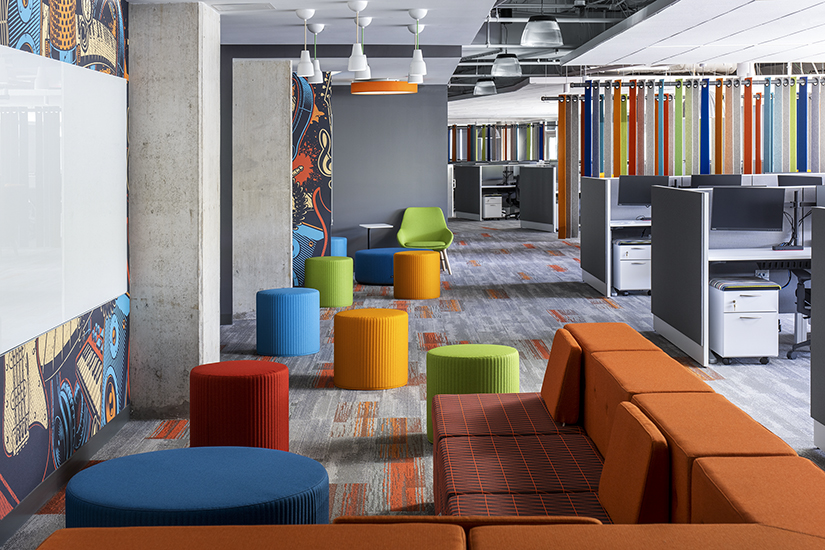|
Getting your Trinity Audio player ready...
|
In March 2020, with no definitive timeline in place, Robert Hines rapidly began preparing Gartner’s offices in Texas and Florida to operate remotely. “We didn’t know how long COVID would last. Two weeks? Months?” says Hines, director of real estate and workforce planning. “The buildings still had to function; you can’t just turn off the electricity, water, and air and make everything go dark.”
Now, Gartner is fully operational as a remote organization, and Hines is preparing for the opposite: the company recently announced that its offices will reopen in September 2021, providing employees with enough time to restart necessary support systems, like daycare. The timeframe will also give Hines an opportunity to prepare the physical offices for a post-COVID-19 world.
Hines arrived at Gartner in early 2019, roughly one year before pandemic lockdown began. And when he did, the team shifted into action mode, shutting down the buildings’ facilities for an indeterminant amount of time and preparing the company’s associates to work from home by setting them up with monitors and company phones, when needed.

“The good thing is that we were set up to work from home—our associates were already issued laptops and had access to their computer and their files,” Hines says. “So, it was really getting them comfortable working from home versus how we get them home.”
Though the Gartner workforce is largely remote at this point, Hines hasn’t noticed too many differences in how he operates on a day-to-day basis. Many of his associates were in other locations even prior to the pandemic, so he was used to video calls and virtual meetings. What has changed, Hines says, is the frequency of those meetings.
“Before, it was more organic to say, ‘Can I bounce this off you?’ That’s a lot harder to do now because you don’t know if the person is in the office or if they’re available now,” he says. “But this time last year, a 15-minute or half-hour meeting might have been an hour. People have gotten a bit more efficient with how they communicate what needs to be done.”
Additionally, Hines notes that many of the tasks that might have, by default, fallen on the real estate department prior to COVID-19—things like reserving a space for an event or help with office setup—have fallen back on individual team managers, which he suspects might become an unexpected benefit.
“One of the challenges [in hiring new people] has always been getting them acclimated to not only Gartner and the brand but the culture,” he says. “Now, it’s about getting to know fellow team members and their styles without that office environment. Individual team leaders now have to rise to the occasion and be the ones who get the answers or direct them to the right person.”
Hines expects Gartner employees to carry their team-centric focus back to the office, and he is prepping the space to be more accommodating to that mindset. He’s emphasizing community-type spaces within the office, using comfortable, casual seating like beanbags and couches, and he believes other offices will be following suit.
“If I’m going to meet with you, we can just go sit on the couches,” Hines says. “I think one of the reasons people like working from home is that they can work whenever they want, however they want, as long as they’re getting the work done. So, if somebody can sit down on a couch, open their laptop, and start clicking through their work, it will represent the evolution within the office. It started before [the pandemic], but I think it’s going to accelerate.”

In the more traditional parts of the office, every other desk in a row will be blocked off to allow more distance between employees. His team is also implementing a more flexible environment in which employees will no longer maintain an assigned desk but can reserve one online prior to arriving. That way, desks won’t sit unused when associates are traveling, and they can configure an in-office schedule when they’re in town.
The biggest challenge right now, Hines says, is to nurture a culture that makes employees feel comfortable returning to work regardless of how many safety measures are implemented. “We know associates want to come back and interact with their team members and have meetings, but we want to be sure that, one, they are safe, and two, that they feel safe doing that,” he says. “It’s going to take quite a while to get people to feel a level of comfort.”
The office environment might look totally different once the world moves past COVID-19, but Hines says that should not deter young professionals interested in a career in real estate.
“I would tell anybody that if this is something they’re interested in, then by all means, get into it and use this time of change to their advantage,” he says. “We’ve had to redefine what we do in offices and how we do it, which allows you to think differently—outside the box.”
Or, in this case, outside the cubicle.


